Post and Beam on Lake Iroquois Keeps the Wood, the Work, and the Dollars Local
July 29, 2019
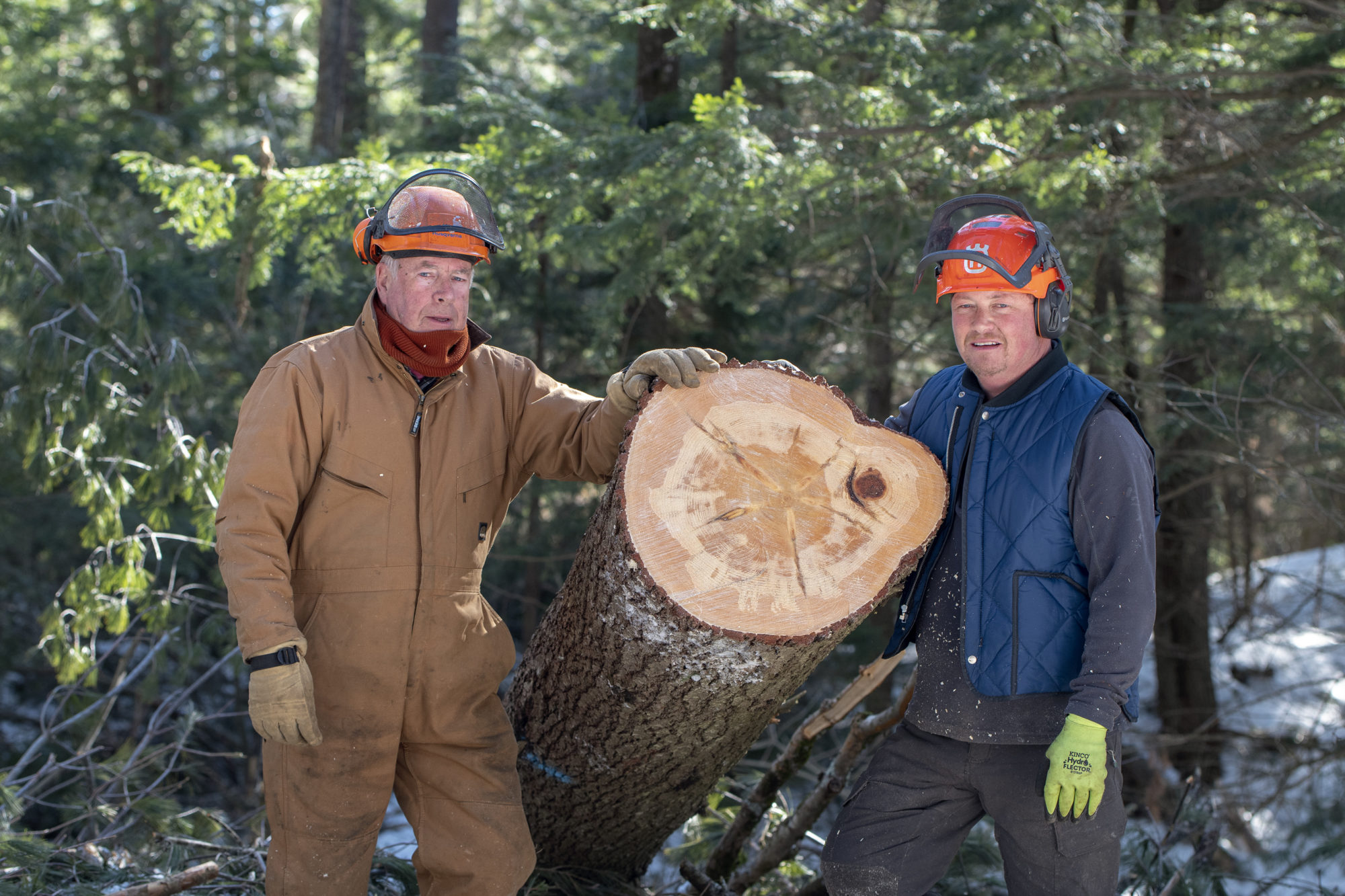
Lead image photo caption: George Wilcox and his son Dave Wilcox stand next to the log of a white pine tree that was cut in February on their West Berlin property. Photo by Erica Houskeeper.
By Christine McGowan, Forest Program Director, Vermont Sustainable Jobs Fund
The story behind Randy Kay’s camp on Lake Iroquois began with an errant voicemail. Andy Harper, owner of Winterwood Timber Frames, received a message that he wasn’t sure was meant for him, but he returned the call anyway and got to talking with Kay, who was looking to build a camp using materials sourced in Vermont. “Using local, responsibly-sourced timber for our post and beam buildings is a central tenet of my business,” said Harper, “so we ended up having a great conversation.”
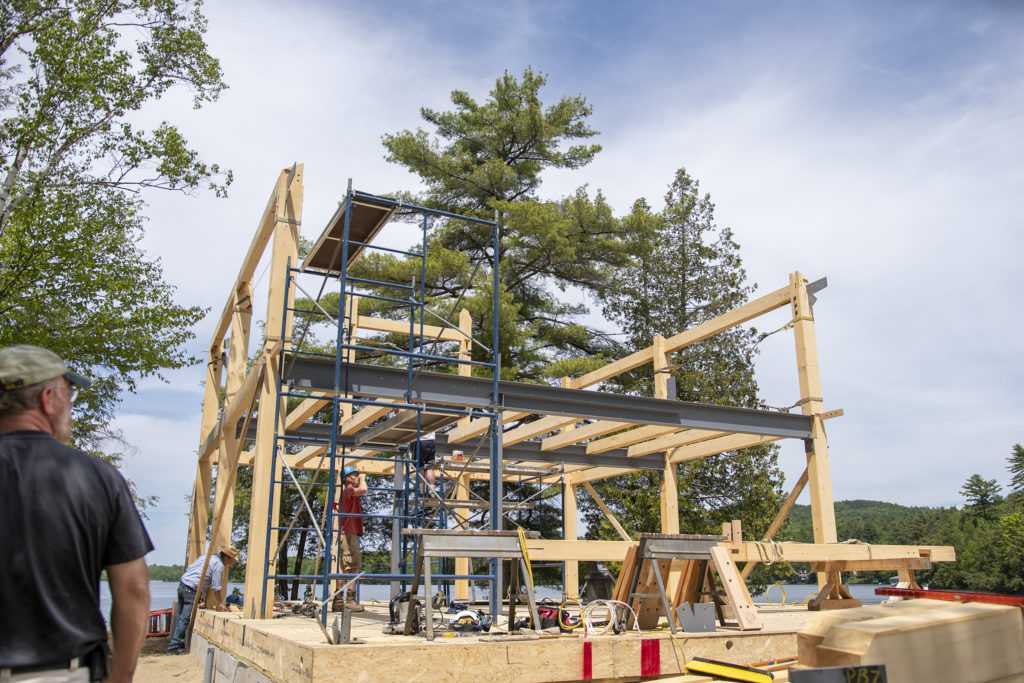
Andy Harper, left, of Winterwood Timber Frames, oversees his crew as they build Randy Kay’s house on Lake Iroquois in Hinesburg. Photo by Erica Houskeeper.
Small-Scale Forestry
Kay hired Harper to build his 1,800 square-foot camp, and began working with architect Timothy Duff to design a year-round home that would fit naturally in the surrounding environment. That same spring, Harper was asked to speak at the Vermont Forest Industry Summit in Burke about utilizing local wood. In the audience, Dave Wilcox, a forester and landowner, heard Harper say that he was looking for small-scale sources of high quality local pine for his timber frames. “He said he didn’t need 100,000 board feet all at once,” said Wilcox, “and that because he paid a premium for the logs, he preferred to walk the land to ensure that the trees were suitable for the home he was building. We had a small mixed softwood stand that was ready to be thinned and included some beautiful 70- to 80-year-old pines, so I introduced myself after the panel and invited Andy to come out to walk my family’s forest.”
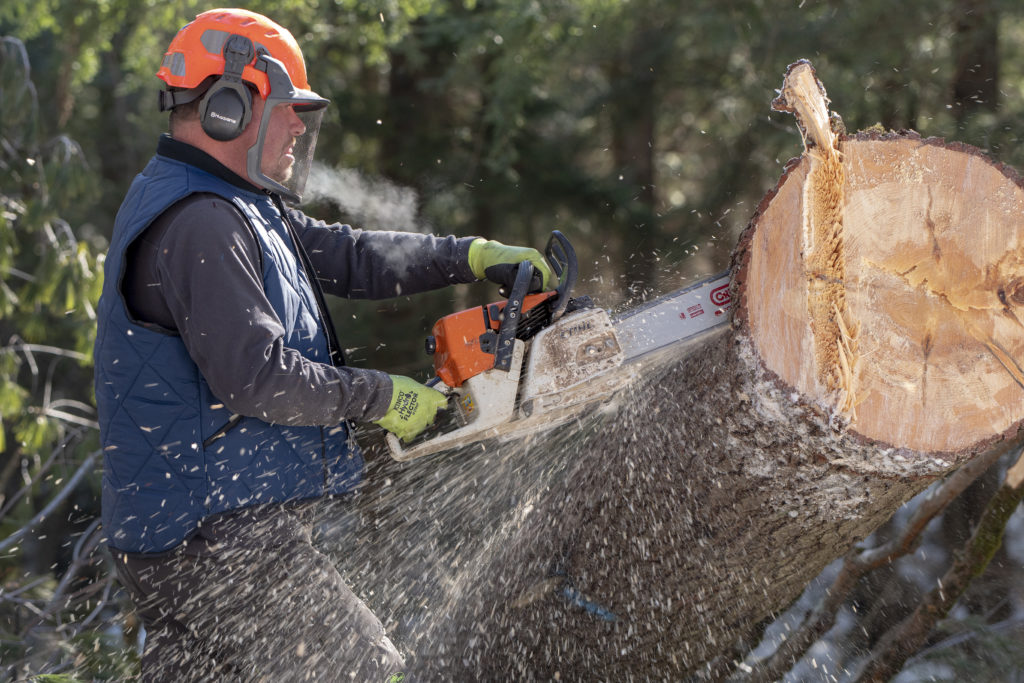
Dave Wilcox harvests a white pine tree on his family’s property in West Berlin. The property, a Certified Tree Farm and enrolled in current use, has been in the Wilcox family since 1973. Photo by Erica Houskeeper.
Wilcox manages more than 200 acres of his family’s forest in West Berlin. The property, which is a Certified Tree Farm and enrolled in current use, has been in the Wilcox family since 1973. As it turned out, the area that was next scheduled for treatment included pines that were exactly what Harper needed for Kay’s camp. Ranging from about 90- to 100-feet, the trees were straight and tall with few knots, but were starting to get choked out. “It was a right-sized deal at the right time for both of us,” said Wilcox, “and it fit within our long-term forest management plan.” The timber sale totaled five small truckloads of White Pine logs, totaling 21,000 board feet, as well as seven cords of Red Maple firewood and about 4,000 board feet of Spruce sawlogs—all in all a pretty light thinning of the six- to seven-acre area. “Even a small sale for a big Canadian mill would typically be in the 50,000-75,000 board foot range,” said Harper. “I try not to inventory timber because pine used for post and beam construction has to be fresh. It doesn’t make sense for me to buy double what I need.” In fact, the name “Winterwood” refers to the harvesting of trees in the winter for spring construction. “Forestry has seasonality,” said Harper, “just like agriculture.”
Adding Value Along the Supply Chain
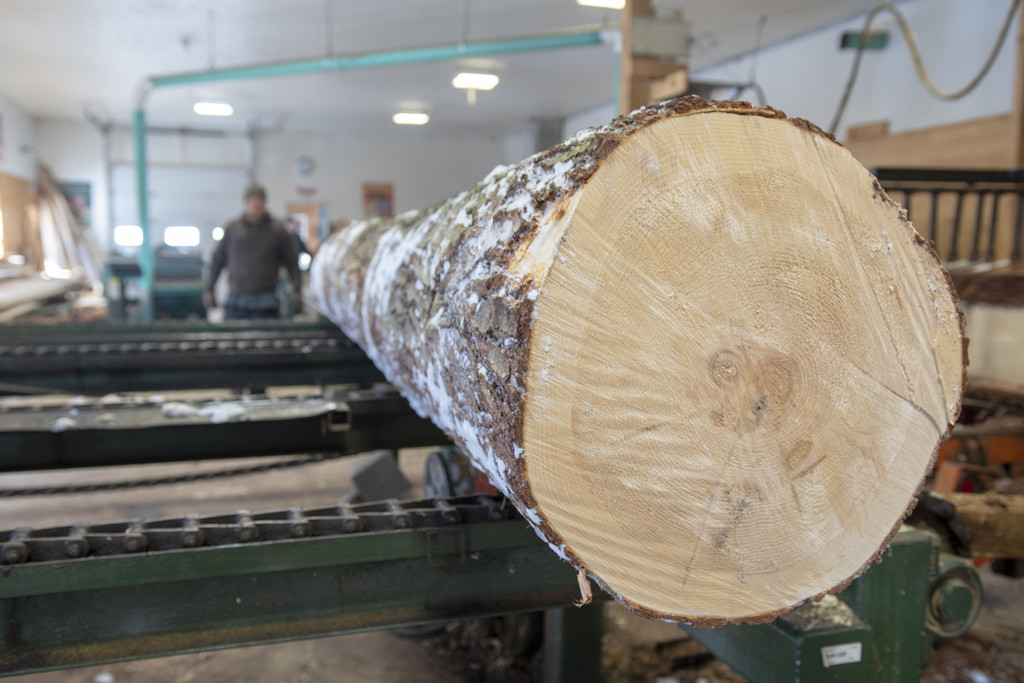
White pine from the Wilcox land is cut at Fontaine Sawmill in East Montpelier. Photo by Erica Houskeeper.
Between the forest and the construction site, the trees harvested last winter from the Wilcox land were processed by a critical third partner, Fontaine Millwork and Forestry. Located in East Montpelier just a few miles from Winterwood Timber Frames, Fontaine and Harper have been friends for a long time. “Marc has the ability to saw logs up to 35-feet long,” said Harper, “which is unusual and truly impressive. He’s used to handling the larger and longer pieces we need for timber framing, so we work together often.” All of the logs from the timber sale were delivered to Fontaine, where Harper then walked through and chose logs for the post and beam. He provided Fontaine with a cut sheet specifying the exact size and length of the beams needed for the camp based on the architect’s plan. The side cuts left over from the logs were dried into lumber that is being used in the camp for flooring. All in all, Harper purchased about 60 percent of the timber sale, and Fontaine purchased the rest to be sold as finished lumber. “Marc played an essential role in the economics of this sale,” said Wilcox. “He was willing to buy the remaining logs that were not suitable for post and beam.”
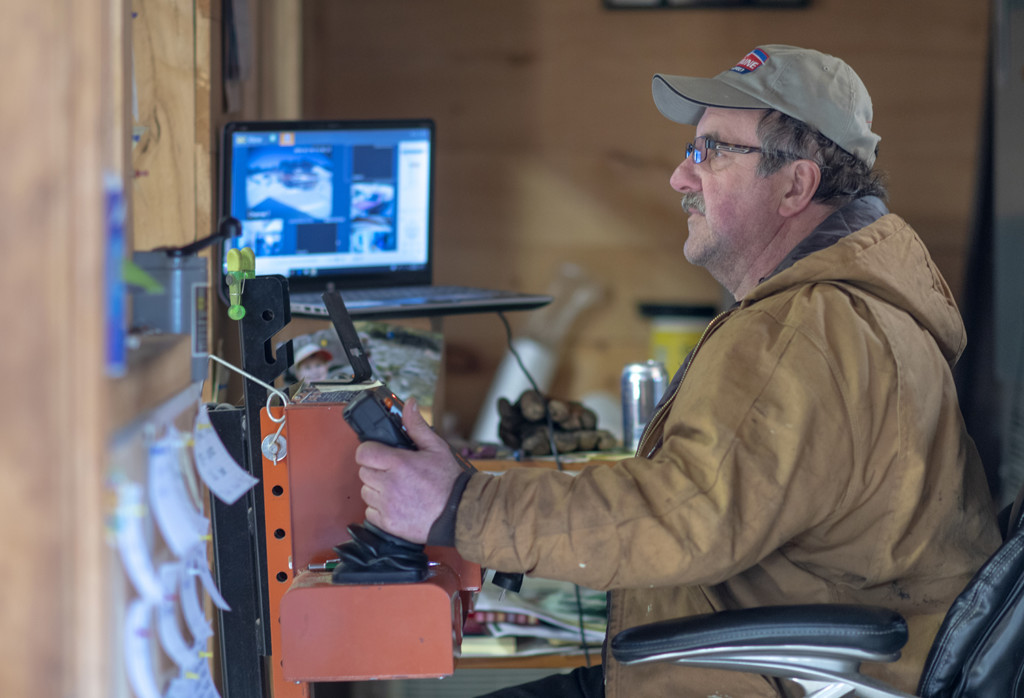
Marc Fontaine of Fontaine Sawmill in East Montpelier is skilled at sawing larger and longer logs that are needed for timber framing.
All three men agree that the relationships forged in a small state allow them to do business differently.
“There’s a degree of trust and a shared love of the forest,” said Wilcox. “We all value the idea that these trees won’t be shipped overseas to become a piece of trim board at a big box store. Instead, they’ll be used in a home where people live and appreciate that the timber grew here in Vermont for almost a century before becoming part of their home.”
Harper agrees. “Not every tree is a commodity,” he adds. “The people who add value along the way have as much of a story as the tree itself.” Harper points to other Vermont businesses such as The Treehouse Hardwoods and Millshop and Green Mountain Grain & Barrel who are also sourcing wood with a history of place. “The idea that local wood products support an important industry here in Vermont is starting to take hold,” he said. “We have to keep making the connection for people between the wood they buy and the forests they love. We have to keep preaching, keep supporting one another, and keep buying local.”
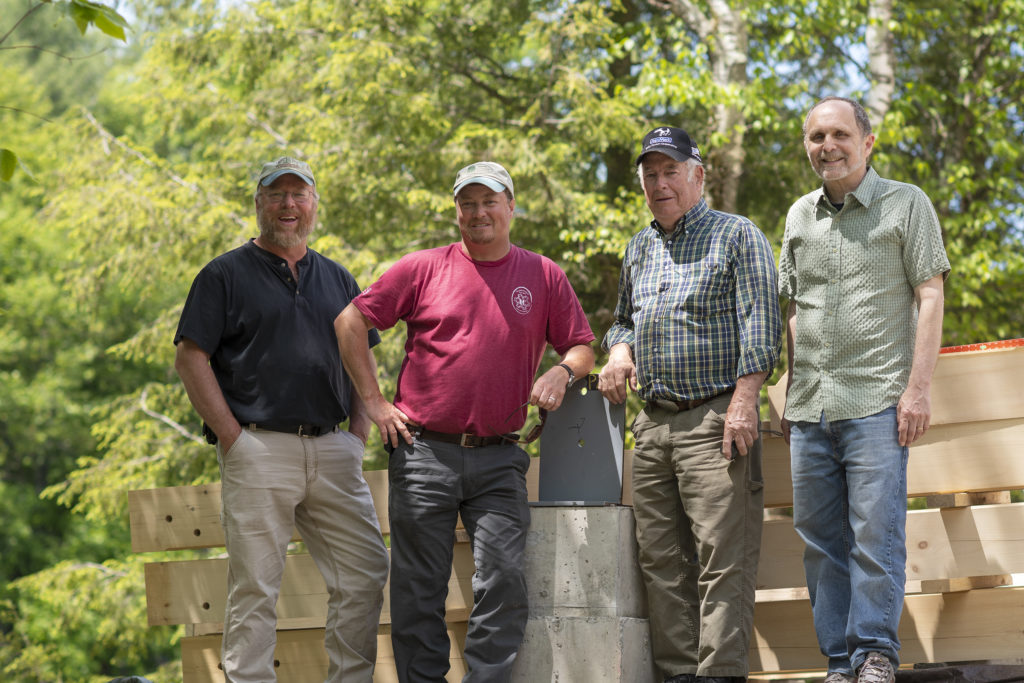
In Vermont, because it is a small state, people in the forest products industry forge lasting relationships. From left, Andy Harper, Dave Wilcox, George Wilcox, and Randy Kay. Photo by Erica Houskeeper.
Wilcox, who was visiting the construction site with his father, George, a retired fieldman for Agri-mark, points out the similarities to Vermont’s local food movement. “People understand that they support the fields and farmers when they buy local food at the farmer’s market,” he said. “But they don’t necessarily make the same connection for wood products. The only way to prevent parcelization and maintain healthy forests for recreation, wildlife, and the environment is to support the working forested landscape. In order for landowners to keep our forests as forests, we need the economics to work.” The value of the wood, however, goes beyond dollars and cents for Kay, who intentionally sourced building materials from Vermont. “I want this home to tell a story,” said Kay. “Now part of the story is that the timber came from the Wilcox family land, and that we supported Vermonters and the forested landscape.”
About the Vermont Forest Industry Network
Vermont’s forest products industry generates an annual economic output of $1.4 billion and supports 10,500 jobs in forestry, logging, processing, specialty woodworking, construction and wood heating. Forest-based recreation adds an additional $1.9 billion and 10,000 jobs to Vermont’s economy. The Vermont Forest Industry Network creates the space for industry professionals from across the entire supply chain and trade association partners throughout the state to build stronger relationships and collaboration throughout the industry, including helping to promote new and existing markets for Vermont wood products, from high quality furniture to construction material to thermal biomass products such as chips and pellets. For more information please visit www.vsjf.org.




